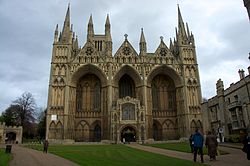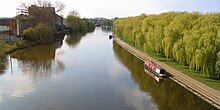Our website is made possible by displaying online advertisements to our visitors.
Please consider supporting us by disabling your ad blocker.
Peterborough
Peterborough | |
|---|---|
 | |
| Motto: "Upon this rock I will build my church" (Upon this rock) | |
 Peterborough Unitary Authority Area shown within Cambridgeshire | |
| Coordinates: 52°34′21″N 00°14′35″W / 52.57250°N 0.24306°W | |
| Sovereign state | United Kingdom |
| Constituent country | England |
| Region | East of England |
| Ceremonial county | Cambridgeshire |
| Admin HQ | Peterborough |
| City status | 1541[1] |
| Incorporated | 1874 |
| Unitary | 1998 |
| Government | |
| • Type | Non-metropolitan district |
| • Governing body | Peterborough City Council |
| • Leadership | Leader and Cabinet |
| • Executive | Conservative |
| • MPs | Stewart Jackson (Con) Shailesh Vara (Con) |
| Area | |
| • Total | 132.58 sq mi (343.38 km2) |
| Population (2005 est.) | |
| • Total | 197,100 |
| • Density | 1,480/sq mi (573/km2) |
| • Ethnicity | 82.5% White 11.7% Asian 2.3% Black 0.8% Other 2.8% Mixed |
| Time zone | UTC±0 (GMT) |
| • Summer (DST) | UTC+1 (BST) |
| Postcode area | |
| Area code | 01733 |
| ISO 3166-2 | GB-PTE |
| ONS code | 00JA (ONS) E06000031 (GSS) |
| OS grid reference | TL185998 |
| NUTS 3 | UKH11 |
| Website | www.peterborough.gov.uk |
Peterborough (/ˈpiːtərbrə/ or /ˈpiːtərbərə/ (![]() listen)) is a cathedral city in the East of England. The population is about 184,500 as of mid–2011. The city is well known for its cathedral.
listen)) is a cathedral city in the East of England. The population is about 184,500 as of mid–2011. The city is well known for its cathedral.
Even though it is part of Northamptonshire, for ceremonial purposes it is inside the county of Cambridgeshire. The city is 75 miles (121 km) north of London. It is on the River Nene which flows into the North Sea, about 30 miles (48 km) to the north-east.
The railway station is an important stop on the East Coast Main Line between London and Edinburgh. The local government area includes Northamptonshire and Rutland to the west, Lincolnshire to the north, and non-metropolitan Cambridgeshire to the south and east.
The topography of the land is flat. In some places it is below sea level, for example in the Fens that are east of Peterborough.
Human settlement began before the Bronze Age, as seen at the Flag Fen archaeological site to the east. There is also evidence of Roman occupation. In the Anglo-Saxon English period of time, a monastery, Medeshamstede was built. This later became Peterborough Cathedral.
The population grew fast after rail transport began in the 19th century. At that time, Peterborough became known for the manufacturing of bricks.


- ↑ Beckett, John V. City Status in the British Isles, 1830–2002 (p.14) Ashgate Publishing, Aldershot, 2005. Retrieved 14 June 2015
- ↑ Grant of arms by letters patent sealed by Garter, Clarenceux and Norroy & Ulster Kings of Arms dated 6 September 1960.
Previous Page Next Page


